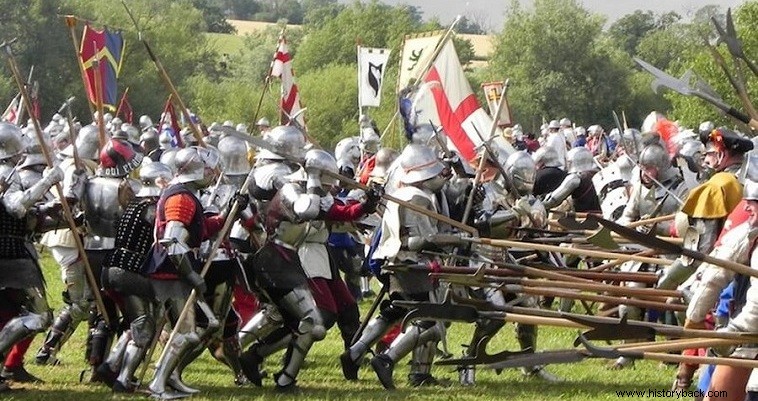
The war between the houses of York and Lancaster shook England for decades. The opposing armies consisted mainly of infantry divisions, which played a catalytic role in the conflict.
The War of the Roses was one of the longest and most destructive civil wars in English history. It began in 1455 and lasted, with breaks, until 1487. In this war, with the English throne as a prize, the ducal houses of Lancaster and York competed.
Because of the emblems of the two houses, the white rose of York and the red rose of Lancaster, the war was called the War of the Two Roses. By tradition, the English armies of the Middle Ages relied on their battle-worthy infantry and not, unlike the other European armies of the time, who relied on their heavy cavalry.
The English Army almost managed to prevail against the strongest European army, the French, during the Hundred Years War, relying on its superiority in infantry and especially in archers armed with the famous Longbow.
This practice continued during the War of the Two Roses. The armies of the two warring factions were essentially the same, with minor differences. It consisted of elements of heavy cavalry, knights and many infantry. The latter were distinguished in several categories.
To the first belonged the noble, infantry knights. English knights, following the tradition established during the Hundred Years' War, used to fight on foot. They did the same, to a large extent, in the War of the Two Roses, strengthening the ranks of the infantry with their presence.
The infantry knights wore heavy armor, which covered the warrior's entire body, literally from head to toe. And they were armed with melee weapons. Their main weapon was the long double-edged sword. But they also brought various other weapons, such as scythes, lances, battleaxes, spears, or even more "exotic" tongue de beof (calf's tongue) and plancon a picot, which were ideal for crushing the opposing chests. The infantry knights functioned, in a way, also as commanders of the infantry divisions.
But the most common types of infantry were archers and spearmen. Archers were equipped with the deadly Longbow. They also carried a sword, helmet, light armor, and sometimes a small, round, shield (buckler). Sections of archers were also formed by the local farmers , who were experienced in the use of the bow, but carried no other armament than a short sword or handbook.
The spearmen carried spears, or scythes, or even spears. They fought in a relatively dense order, close to the archers, the results of whose shots they had the task of exploiting, breaking up the enemy line by fighting from the cluster , since first she had been worn out by the friendly arrows.
The other two types of infantry that saw action in this war conflict came primarily from continental Europe. They were mercenary sarissa bearers and arquebus bearers. The first were mainly Flemish, Burgundian or German and fought in dense formations. The latter were Flemish, French or German and fought, with early firearms , in open formations, as acrobolists. These two types were mainly used by the House of York.
Welsh infantry, armed with long spears, sword and sometimes a small shield, and Welsh archers were extensively used on both sides. The House of Lancaster also employed large numbers of Irish footmen, most of whom carried javelins, shields and handbooks and fought in loose order. The rest carried the same weaponry, but fought in acrobolism formation, like the ancient Psiloi.
The mercenary spearmen from the Brittany peninsula fought in the same way, as well as the Burgundian "grenadiers" who fought in the service of the House of York. The so-called Petardiers who used early explosive devices mainly in siege operations.
The infantry of the time fought in at least two lines of battle, with the second supporting the first, covering any gaps that opened up in the first. After exchanging artillery fire, early rifle balls, and arrows, the two lines approached each other and the battle was judged to be hand-to-hand combat , although and as long as the opposing line was not already broken by the missiles and gunfire.
